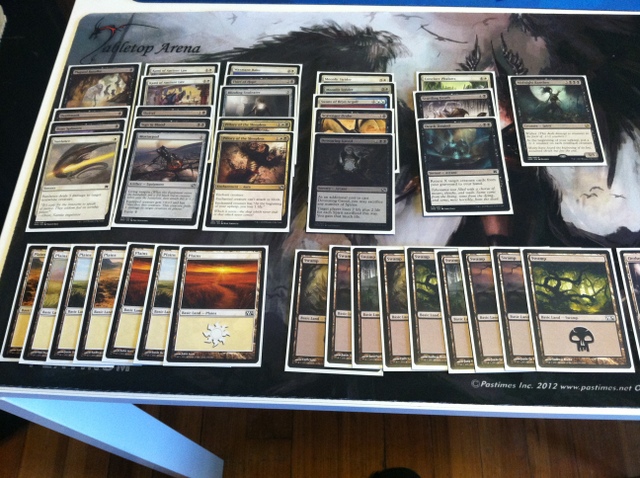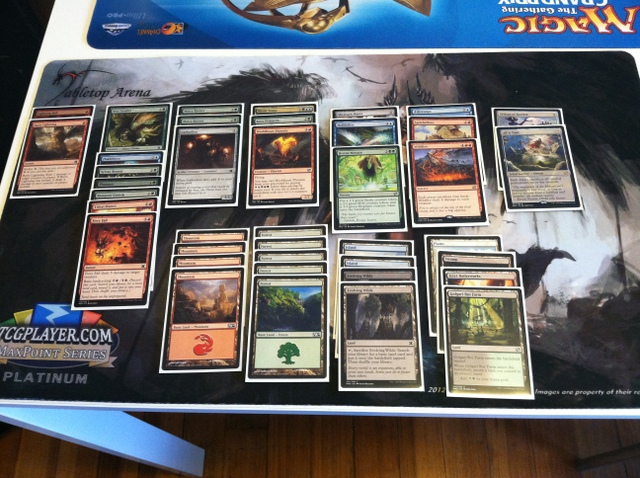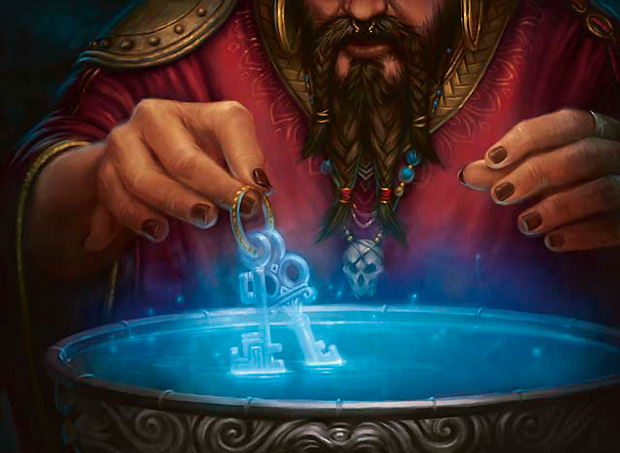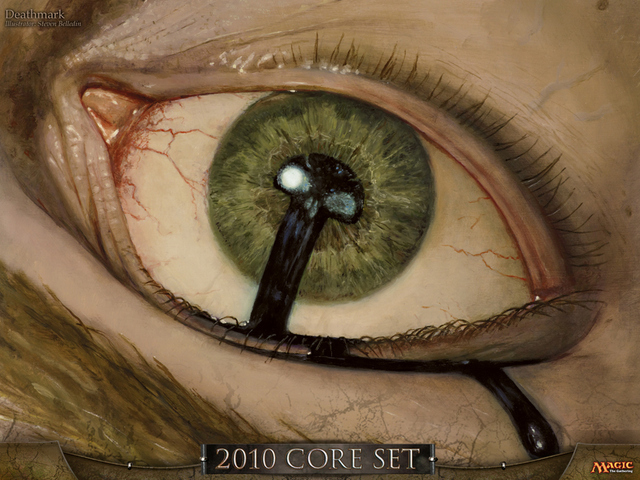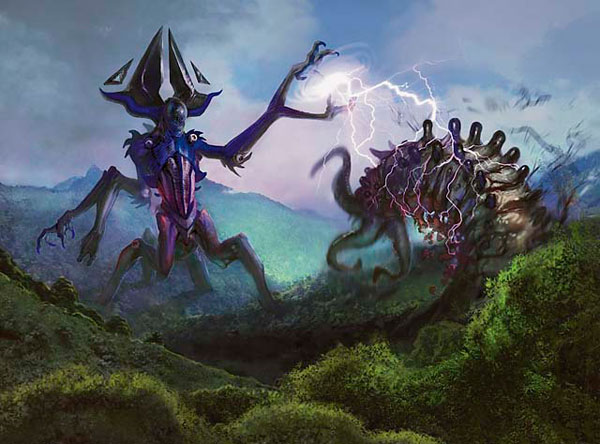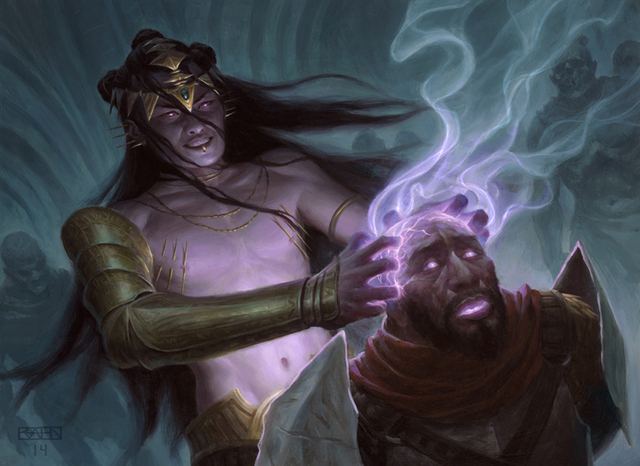After failing to make day two with my 6-3 record in Vegas, Erica and I decided to run it back the following day and play Two-Headed Giant (2HG). We dropped the $80 for eight packs of Modern Masters and built these two decks:
Our final record was 3-1-1 with our only loss to a terrible case of mana screw. My proudest moment during GP Vegas came in round four when Erica drew [casthaven]Swans of Bryn Argoll[/casthaven]and I had a [casthaven]Wildfire[/casthaven] in hand for the ultimate wombo combo.
“We just slam it right?”
Our opponents speculated out loud that I was about to cast an [casthaven]All is Dust[/casthaven] on the busy board. Instead I played [casthaven]Wildfire[/casthaven], drew four cards, killed all of their creatures and most of their lands. Oh yeah and Erica still had a Swans. Our opponents were justifiably salty.
We were able to get 10 more packs of Modern Masters, two GP Vegas T-shirts, and two packs of Dragons with our winnings, which makes up for the usually dismal prize support of 2HG events. It also made me want to write an article exclusively about Two-Headed Giant.
There’s a lot of things I like about Two-Headed Giant. I’m drawn to the format by the collaborative aspect of the game, the free mulligans, and the board states that resemble commander free for all’s. I play 2HG every chance I get, though in truth this is usually only when a new set comes out or a big SCG event happens nearby. Despite the fact that most people play 2HG on a seldom basis, and that it’s a casual format without high level tournament support, I’m always amazed at how little people know about the format. I’ve noticed a lot of my opponents playing the game like it was a game of one vs. one instead of a four player game with an increased life total. I’ve seen players expend their resources way too early, aggressively using removal on filler creatures. I’ve seen players keep subpar hands when they still had a free mulligan. I’ve seen teams win the die roll, and then choose to play. While I mentally fist pump every time this last one happens, I think it’s only fair to explain why it probably shouldn’t. So without further ado, here is a brief list of things you can do to improve your game while playing Two Headed Giant Sealed.
- Draw. Always Draw.
While it’s considered conventional wisdom to choose to play in most formats, imagine if choosing to draw meant you got to draw two cards instead. Oh and also, you wouldn’t even have to discard down to seven at the end of the turn. That’s what drawing in 2HG means. It means you get a free [casthaven]Divination[/casthaven]. But wait, it’s not exactly that easy right? There are probably still situations against really aggressive decks where you would still opt to play, tempo is important after all. The difference in 2HG is that your life total is 30. The ground gets gummed up quickly and tempo very quickly becomes secondary to card advantage. Choosing to be on the play is a losing proposition, it puts you down cards in a format where the games go long and the extra cards are very relevant.
- Play Sideboard/Niche Cards
You only play one game of 2HG so you don’t have an opportunity to side in niche cards. In Modern Masters, [casthaven]Flash Freeze[/casthaven], [casthaven]Combust[/casthaven], [casthaven]Deathmark[/casthaven], and [casthaven]Celestial Purge[/casthaven] are all totally reasonable maindeckable spells. They are efficient pieces of removal and one of your two opponents will have targets. Same goes for [casthaven]Terashi’s Grasp[/casthaven], [casthaven]Smash to Smithereens[/casthaven], and [casthaven]Sundering Vitae[/casthaven]. The probability that your opponent will have a good target is very high. When I played 2HG in Vegas I had a deck with [casthaven]Flashfreeze[/casthaven] and [casthaven]Plummet[/casthaven] while my other head had [casthaven]Deathmark[/casthaven] and [casthaven]Kami of Ancient Law[/casthaven]. They were very rarely dead cards with the upside being much higher than playing a curve-filler creature. I would always start [casthaven]Deathmark[/casthaven] over [casthaven]Sickle Ripper[/casthaven], [casthaven]Combust[/casthaven] over [casthaven]Soulbright Flamekin[/casthaven], and [casthaven]Plummet[/casthaven] over [casthaven]Aquastrand Spider[/casthaven].
- Make Your Curve Higher
While we’re on the topic of curve filler creatures, I want to suggest that you adjust your curve for 2HG. While you shouldn’t abandon the idea of a good curve completely, it’s okay to play fewer two and three drops to accommodate bigger spells. You do need some early plays to gum up the ground a bit and to avoid taking too much damage before stabilizing, but this isn’t a one vs. one game where a good curve alone will win you the game. Creatures very quickly become outclassed and once they have to sit back and not attack, I’d much rather have a bigger threat.
- Play Cards that Target Each Opponent
One of the many quirks of 2HG is that spells that target each opponent scale up in a game where you have two opponents. In Theros, [casthaven]Grey Merchant of Asphodel[/casthaven] could destroy your opponents with just a little bit of devotion. In Khans, each [casthaven]Kheru Bloodsucker[/casthaven] activation was a six point life swing, they lost four life and you gained two. The thing is these cards were totally reasonable in one vs. one but just happened to get better in a format where you have multiple opponents. In other cases, cards go from utter garbage to total insanity in 2HG. [casthaven]Tasigur’s Cruelty[/casthaven] is a card totally unplayable in most forty and sixty card decks, but more or less defined 2HG for Khans/Fate Sealed and Dragons/Fate Sealed. In most cases, you would pay for a [casthaven]Mind Rot[/casthaven] but get something closer to [casthaven]Wit’s End[/casthaven], with each opponent discarding two cards.
I think these are pretty straight forward concepts but ones I don’t seem employed all that often when I’m playing 2HG. While you might not play the format all that often, when you do get the chance the chance to play, choose to be on the draw, play powerful cards that are a bit narrow for one vs. one play, cut some filler and increase your curve, and lastly enjoy cards that affect multiple opponents or players.
At age 15, while standing in a record store with his high school bandmates, Shawn Massak made the uncool decision to spend the last of his money on a 7th edition starter deck (the one with foil [casthaven]Thorn Elemental[/casthaven]). Since that fateful day 11 years ago, Shawn has decorated rooms of his apartment with MTG posters, cosplayed as [casthaven]Jace, the Mindsculptor[/casthaven], and competes with LSV for the record of most islands played (lifetime). When he’s not playing Magic, Shawn works as a job coach for people with disabilities and plays guitar in an indie-pop band.

